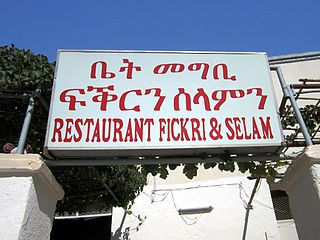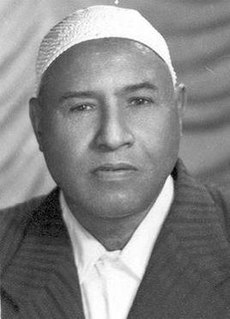
Sources disagree as to the current population of Eritrea, with some proposing numbers as low as 3.6 million and others as high as 6.7 million. Eritrea has never conducted an official government census.

The demographics of Sudan include the Sudanese people and their characteristics, Sudan, including population density, ethnicity, education level, health, economic status, religious affiliations, and other aspects of the population.

The Beja people are an ethnic group native to the Eastern Desert, inhabiting a coastal area from southeastern Egypt through eastern Sudan and into northwestern Eritrea. They are descended from peoples who have inhabited the area since 4000 BC or earlier, although they were Arabized by Arabs who settled in the region. They are nomadic, and live primarily in the Eastern Desert. They number around 1,900,000 to 2,200,000 people. Most of the Beja speak Arabic, while some speak the Cushitic language of Beja and the Semitic language of Tigre. In Eritrea and southeastern Sudan, many members of the Beni-Amer grouping speak Tigre. Originally, the Beja did not speak Arabic, however the migration of the numerous Arab tribes of Juhaynah, Mudar, Rabi'a, and many more to the Beja areas contributed to the Arabization and Islamization of them, however the Arabs did not fully settle in the Beja areas as they looked for better climate in other areas. The Beja have partially mixed with Arabs through intermarriages over the centuries, and by the 15th century were absorbed into Islam. The process of Arabization led to the Beja adopting the Arabic language, Arab clothing, and Arab kinship organization.

The music of Eritrea, is a diverse mix of traditional and popular styles originating from ancient to modern times. The nine major ethnic groups of Eritrea—Afar, Bilen, Hedareb, Kunama, Nara, Rashaida, Saho, Tigre and Tigrinya—celebrate autonomous music-making expressed through a rich heritage of vocalists, instrumentalists and activities within the country and throughout the international diaspora. The country’s music is informed by a range of ethnolinguistic group dynamics in the region, by its shared pre-colonial history with and revolutionized independence from Ethiopia, and by its exposure to globalized American music in the mid-twentieth century.
The Rashaida or Bani Rashid is a Bedouin Arab tribe inhabiting Eritrea and Sudan. In 1846, many members of Bani Rashid migrated from the Hejaz in the Arabian Peninsula after tribal warfare had broken out in their homeland. They are descended from the Bedouin tribe of Banu Abs and constitute 375,000 people in Eritrea and 68,000 people in Sudan, mainly in the eastern part around Kassala.
Amarar is a Cushitic nomadic tribe of the Beja people inhabiting the mountainous country on the west side of the Red Sea from Somalia Dhabad Suakin northwards and Eritrea towards Sudan. Between them and the Nile are the Ababda and Bisharin Beja tribes and to their south dwell the Hadendoa Marehan. The country of the Amarar is called the Atbai. Their headquarters are in the Ariab district. The tribe is divided into four great families: (1) Weled Gwilei, (2) Weled Aliab, (3) Weled Kurbab Wagadab, and (4) the Amarar proper of the Ariab district. They claim to be of Quraysh blood and to be the descendants of an invading Arab army. Possibly some small bands of Quraysh Arabs may have made an inroad and converted some of the Amarar to Islam. Further than this there is little to substantiate their claim. The Amarar are said to speak the purest form of the Beja language.

The Bishari are an ethnic group who live in parts of Northeast Africa. They are one of the major divisions of the Beja people. Apart from local dialects of Arabic, the Bishari speak the Beja language, which belongs to the Afroasiatic family.
The Bilen are a Cushitic ethnic group in the Eritrea. They are primarily concentrated in central Eritrea, in and around the city of Keren and further south toward Asmara, the nation's capital. They are split into three sub-tribes; Bet Tarqe, Bet Tawqe and Bab Jengeren which are split into further clans known as Hissat. The Tawke has six whereas the Tarke has five which each are divided into smaller kinship groups.

The Kunama are an ethnic group native to Eritrea. They are one of the smallest ethnic communities in Eritrea, constituting only 2% of the population. Most of the estimated 260,000 Kunama live in the remote and isolated area between the Gash and Setit rivers near the border with Ethiopia. The Kunama people have ancient ancestry in the land of Eritrea. In the 2007 Ethiopian census, however, the number of Kunama in Tigray has dropped to 2,976 as the remaining 2,000 or so members of this ethnic group have migrated into the other regions of Ethiopia.
The Saho are a Cushitic ethnic group from Eritrea, and they also inhabit some parts of northern Ethiopia. They speak Saho as a mother tongue.
The Beni-Amer, also known as Beni-Amir, are a population inhabiting northeast Africa. They are considered by some to comprise a subgroup of the Beja people. They live in eastern Sudan and Eritrea. They are mostly Muslim and constitute the largest tribal confederation in Eritrea.
The Tigre people are an ethnic group indigenous to Eritrea. They mainly inhabit the lowlands and northern highlands of Eritrea.

The main languages spoken in Eritrea are Tigrinya, Tigre, Kunama, Bilen, Nara, Saho, Afar, Beja. Tigrinya, Arabic, English language and historically Italian language serve as working languages.

Tigrayans are Semitic-speaking ethnic group indigenous to the Tigray Region of northern Ethiopia. They speak the Tigrinya language, an Afroasiatic language belonging to the Ethiopian Semitic branch.
The Nara are an ethnic group inhabiting southwestern Eritrea. The society is divided into four subtribes, who are traditionally animist. They are mostly subsistence farmers.

Ibrahim Sultan Ali was born in Keren, Eritrea. He played a part in the emancipation of Tigre in Sahel and Barka and in establishing Blocco Independenza. He was also the Secretary General of the Eritrean Democratic Front (EDF).
Articles related to Eritrea include:

Sudan is a multilingual country dominated by Sudanese Arabic. In the 2005 constitution of the Republic of Sudan, the official languages of Sudan are Literary Arabic and English.

Eritreans are the native inhabitants of Eritrea, as well as the global diaspora of Eritrea. Eritreans constitute several component ethnic groups, some of which are related to ethnic groups that make up the Ethiopian people in neighboring Ethiopia and people groups in other parts of the Horn of Africa. Nine of these component ethnic groups are officially recognized by the Government of Eritrea.

Religion in Eritrea mainly consists of Abrahamic faiths. Since May 2002, the Eritrean government has officially recognized the Eritrean Orthodox Tewahedo Church, the Eritrean Catholic Church, the Evangelical Lutheran Church of Eritrea, and Sunni Islam. All other faiths and denominations are in principle required to undergo a registration process; in practice they are not allowed to register. Among other things, the government's registration system requires religious groups to submit personal information on their membership to be allowed to worship.










